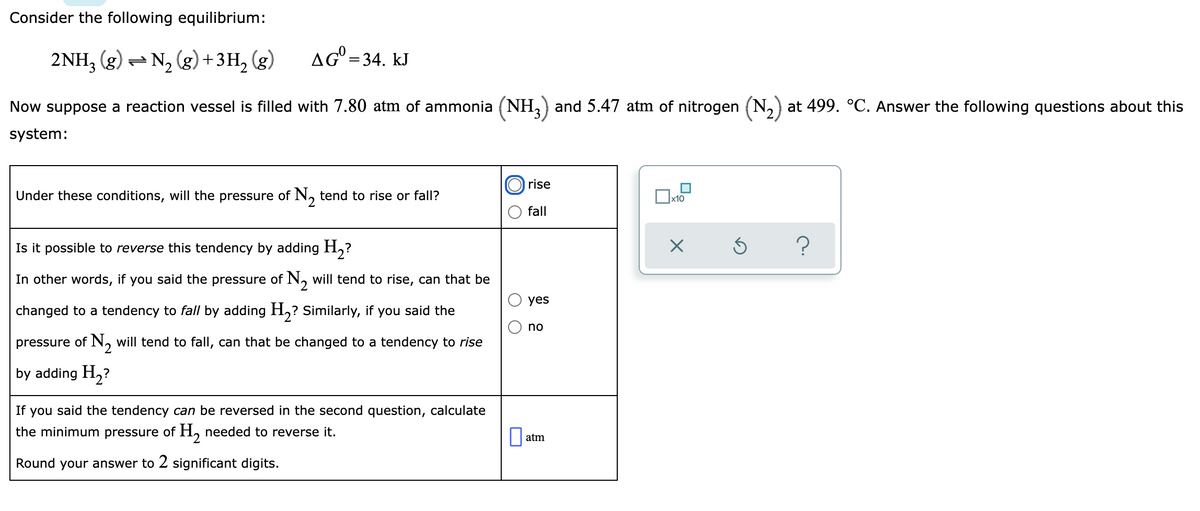Consider the following equilibrium: 2NH; (g) – N, (g) + 3H, (g) AG° =34. kJ Now suppose a reaction vessel is filled with 7.80 atm of ammonia (NH,) and 5.47 atm of nitrogen (N,) at 499. °C. Answer the following questions about this system: O rise Under these conditions, will the pressure of N, tend to rise or fall? O fall Is it possible to reverse this tendency by adding H,? In other words, if you said the pressure of N, will tend to rise, can that be O yes changed to a tendency to fall by adding H,? Similarly, if you said the O no pressure of N, will tend to fall, can that be changed to a tendency to rise by adding H,? If you said the tendency can be reversed in the second question, calculate the minimum pressure of H, needed to reverse it. |atm Round your answer to 2 significant digits.
Consider the following equilibrium: 2NH; (g) – N, (g) + 3H, (g) AG° =34. kJ Now suppose a reaction vessel is filled with 7.80 atm of ammonia (NH,) and 5.47 atm of nitrogen (N,) at 499. °C. Answer the following questions about this system: O rise Under these conditions, will the pressure of N, tend to rise or fall? O fall Is it possible to reverse this tendency by adding H,? In other words, if you said the pressure of N, will tend to rise, can that be O yes changed to a tendency to fall by adding H,? Similarly, if you said the O no pressure of N, will tend to fall, can that be changed to a tendency to rise by adding H,? If you said the tendency can be reversed in the second question, calculate the minimum pressure of H, needed to reverse it. |atm Round your answer to 2 significant digits.
Chapter17: Spontaneity, Entropy, And Free Energy
Section: Chapter Questions
Problem 78E: Consider the following reaction at 298 K: 2SO2(g)+O2(g)2SO3(g) An equilibrium mixture contains O2(g)...
Related questions
Question

Transcribed Image Text:Consider the following equilibrium:
2NH, (g)
- N, (g) + 3H, (g)
AG = 34. kJ
'2
Now suppose a reaction vessel is filled with 7.80 atm of ammonia (NH,) and 5.47 atm of nitrogen (N,) at 499. °C. Answer the following questions about this
system:
rise
Under these conditions, will the pressure of N, tend to rise or fall?
|x10
fall
Is it possible to reverse this tendency by adding H,?
In other words, if you said the pressure of N, will tend to rise, can that be
yes
changed to a tendency to fall by adding H,? similarly, if you said the
no
pressure of N, will tend to fall, can that be changed to a tendency to rise
by adding H,?
If you said the tendency can be reversed in the second question, calculate
the minimum pressure of H, needed to reverse it.
||atm
Round your answer to 2 significant digits.
O O
Expert Solution
This question has been solved!
Explore an expertly crafted, step-by-step solution for a thorough understanding of key concepts.
This is a popular solution!
Trending now
This is a popular solution!
Step by step
Solved in 3 steps with 3 images

Knowledge Booster
Learn more about
Need a deep-dive on the concept behind this application? Look no further. Learn more about this topic, chemistry and related others by exploring similar questions and additional content below.Recommended textbooks for you


Chemistry: An Atoms First Approach
Chemistry
ISBN:
9781305079243
Author:
Steven S. Zumdahl, Susan A. Zumdahl
Publisher:
Cengage Learning

Chemistry
Chemistry
ISBN:
9781305957404
Author:
Steven S. Zumdahl, Susan A. Zumdahl, Donald J. DeCoste
Publisher:
Cengage Learning


Chemistry: An Atoms First Approach
Chemistry
ISBN:
9781305079243
Author:
Steven S. Zumdahl, Susan A. Zumdahl
Publisher:
Cengage Learning

Chemistry
Chemistry
ISBN:
9781305957404
Author:
Steven S. Zumdahl, Susan A. Zumdahl, Donald J. DeCoste
Publisher:
Cengage Learning

Chemistry: Principles and Reactions
Chemistry
ISBN:
9781305079373
Author:
William L. Masterton, Cecile N. Hurley
Publisher:
Cengage Learning

Chemistry for Engineering Students
Chemistry
ISBN:
9781337398909
Author:
Lawrence S. Brown, Tom Holme
Publisher:
Cengage Learning

Chemistry: The Molecular Science
Chemistry
ISBN:
9781285199047
Author:
John W. Moore, Conrad L. Stanitski
Publisher:
Cengage Learning